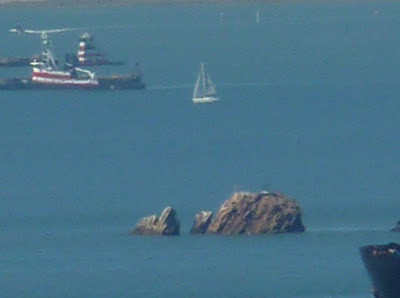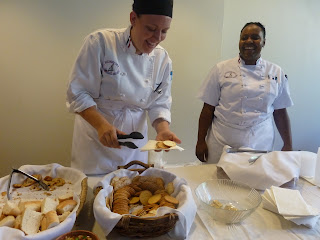"Don't jump!" (photo by Jean Womack)
I shall never forget my first history of printmaking class at San Francisco State University. The great Dr. Richard Mann was teaching. He stood on the stage of the little movie theatre with two huge side-by-side screens behind him, students filling the seats in the darkened theatre. Even students who were not enrolled in the class, had come to hear him lecture. The first slide was a print by Kathe Kollwitz, of peasants running with heads bowed and hidden under layers of cloth as if to ward off blows.
"What can we say about this print?" he asked the audience.
There was a long, deafening silence.
Finally someone said, "It's very dark."
Someone else said, "It's bold."
Of course the art history professor had plenty to say about the prints, almost as if he was describing protestors running from the police in Ogawa plaza in Oakland. He knew them like he knew his own family. As we sat there in the darkness, the projector flipped one after another of Kollwitz's prints on to the screen, side by side, so we could compare one to the other, and find the similarities and differences. We had a lot of "ah, ha," moments that day as we did in the following days of that course. It was one of the most exciting courses I took at the university.
Another great art history prof is Bonnie Holt who teaches at Contra Costa Collge. As she showed nude paintings of the Italian Rennaisance side by side on screens not quite as large as those at San Francisco State, she labeled each nude as a prostitute. It went on and on, week after week. All of the nudes were prostitutes. Then one of the women brought her high school daughter with her to class, and all the talk about prostitutes immediately ceased.
Another exciting professor at State was the university art department chair, Sylvia Walters, who issued a newsletter from time to time, called, "Letter from the Chair," The first one I read left an indelible impression on my mind. "The east coast reviewers did not describe the art in the Whitney Biennial well enough so we could know what they were talking about," she wrote. I cringed, reading that criticism from my beloved printmaking instructor. Going to the university can make a true believer out of you.
So here I would like to quote from my favorite high school art textbook, "TheVisual Experience," by Jack Hobbs and Richard Salome. "Art criticism, as defined here, is a systematic description, analysis, interpretation, and evaluation of an artwork. Sometimes criticism includes just the first three stages...Professional criticism of the arts can be found in newspapers, magazines, radio and television. Basically, professional critics inform and educate the public through studying and writing about works of art. People who are not professional critics can benefit from criticizing art in many ways: learning more about art and criticism, developing their own taste and sharing experiences with others."
Describing means using the art elements words color, value, line, shape, texture, space (perspective), and scale to describe the work of art, and telling the subject and what's on the label of the picture. Analyzing means compare and contrast, and using art principles words composition (relationships), pattern, movement, dominance, balance, unity, and rhythm. Interpretation means forming a hypothesis about the meaning of the work and giving examples to support your hypothesis. Evaluation means judging the work on craftsmanship, design quality, expressiveness, personal response, originality and comparison with other works in the genre. Maybe the writer does not have to include every single one of these topics but at least some from each category. This stuff is all in the California State standards--maybe not those exact words, but pretty close.
In elementary school, art criticism is practiced like this: kids are given a bunch of sticky notes and told to write something nice about each art work on a sticky note, using the art words, and place it on the art work. Dr. Bruce Harter, superintenent of the WCCUSD, introduced an educator to the people at the Richmond Economic Summit who said that kids in an elementary school asked one of their classmates to keep drawing a butterfly over and over again until he drew it to their satisfaction. That's another form of art criticism, and it's also called learning how to draw.
In art history textbooks, there is often an official explanation for a work of art that does not match up with the picture itself, and leaves a person wondering, what really happened? It's like the art history prof who stopped talking about nudes when the high school student came into the room. You are being talked to at a high school level of information when you read the daily newspaper or watch a news report. Knowlege is power. People who know more than you do often have power over you. They know why nothing ever turns out the way you want it to and you can't seem to do anything about it.
When you are looking at a work of art without knowing the artist, you do not know if the artist is a man or a woman or a white person or a black person. Unless you are familiar with that artist's previous work, you don't know if the artist is young or old, married or single. Your experience is just between you and the work of art. You have to ask yourself, does this work of art speak to me? If so, what is it saying?
As you can see, I think that art is an important form of communication.





















































